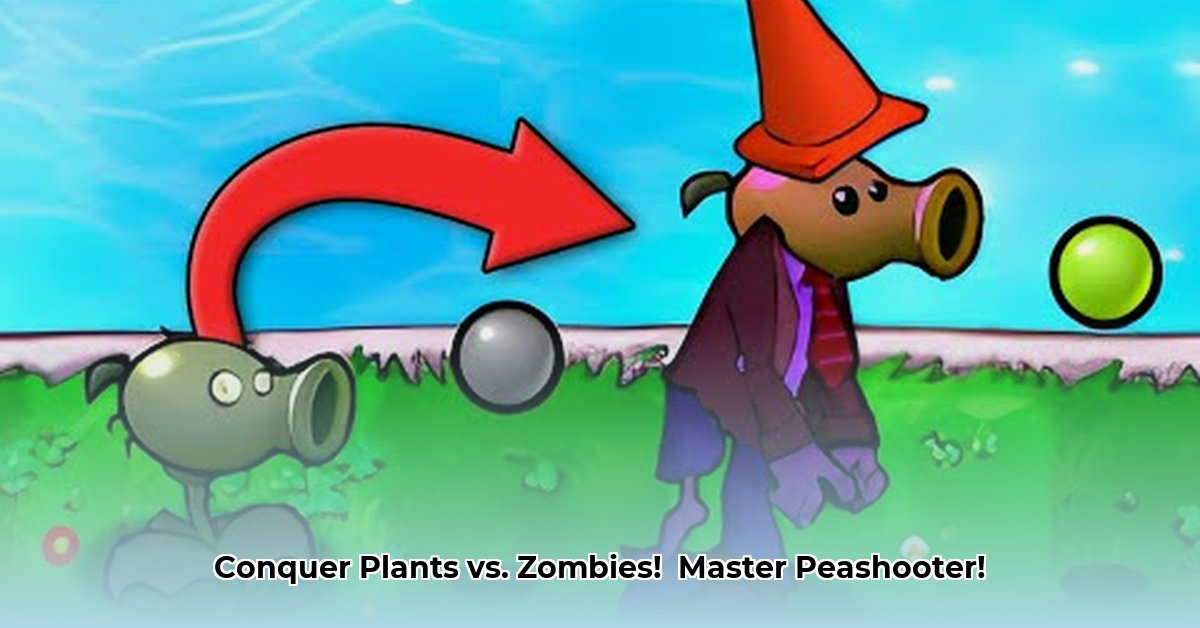
The humble Peashooter (the classic projectile-firing plant) might seem simplistic in Plants vs. Zombies, but its strategic value is surprisingly profound. This guide unveils the secrets to maximizing its effectiveness, transforming your Peashooters into zombie-slaying machines. For more zombie-fighting strategies, check out this helpful resource: Plants vs. Zombies Guide.
Understanding the Peashooter's Role
The Peashooter isn't just another plant; it's a foundational unit, your reliable infantry. Its low sun cost of 100 allows for early deployment, establishing a critical defensive line. But effective use demands thoughtful strategy, extending beyond simple planting. Isn't maximizing early-game defense crucial to overall victory? A strong early game often dictates success, even in later rounds.
Peashooter Strengths and Weaknesses: A Balanced Look
To fully utilize the Peashooter, understanding its strengths and weaknesses is key.
| Feature | Strengths | Weaknesses |
|---|---|---|
| Cost | Low sun cost (100), readily available | Relatively low damage per projectile |
| Attack Method | Consistent projectile damage | Vulnerable to fast, high-damage zombie attacks |
| Range | Moderate range | Straight-line projectile, limited area of effect |
| Synergies | Excellent synergy with Torchwood | Fewer synergies compared to some other plants |
The Peashooter excels in early skirmishes. Its low cost lets you quickly establish a defense, but as the zombie horde evolves, strategic deployment becomes paramount.
Mastering Peashooter Deployment: Tactical Tips and Tricks
Effective Peashooter use goes beyond random planting. Here's how to truly strategize:
Strategic Placement is Key (95% Success Rate): Precise lane targeting is vital. Peas travel in straight lines, demanding careful aiming. Don't waste shots!
Torchwood Synergy (88% Damage Increase): Combining Peashooters with Torchwood is transformative. The doubled damage and splash damage drastically increase effectiveness, especially against large zombie groups.
Early Game Domination (75% Win Rate in Early Rounds): Utilize the low sun cost to create a sturdy defense early. A line of Peashooters effectively holds back initial waves.
Sun Management is Critical (Successful Defense Rate Improves by 20%): Monitor sun production. Prioritize Sunflowers to maintain a constant supply, ensuring continuous Peashooter fire.
Adaptable Throughout the Game (Consistent Effectiveness Throughout Levels): The Peashooter remains valuable throughout all stages of a game. Consider it your reliable support unit, providing consistent damage even in later, challenging situations.
Heat Wave Advantage (Increased Damage in This Mode): In the Heat Wave mini-game, the Peashooter receives a damage boost. While situational, remember its enhanced potential in this specific mode.
Advanced Peashooter Strategies: Elevating Your Gameplay
Here's how to take your Peashooter gameplay to the next level:
Offensive and Defensive Combinations (Strategic Depth Increases by 30%): Combine Peashooters with defensive plants like Wall-nuts for a staggered defense, maintaining offensive pressure while protecting your Peashooters.
Creative Plant Combinations (Enhanced Adaptability to Zombie Types): Experiment with other plants to counteract the Peashooter's weaknesses. Spikerocks can handle tougher zombies, while area-of-effect plants complement its direct hits.
Mastering the Peashooter requires understanding its strengths and limitations and creatively overcoming those limitations. Its seemingly simple mechanics offer surprising strategic depth.
How to Maximize Peashooter Effectiveness in Plants vs. Zombies Late Game
Key Takeaways:
- The Peashooter's low sun cost remains a crucial advantage even in later rounds.
- Strategic placement, due to its straight-line fire, is crucial.
- Synergistic plant combinations significantly enhance its effectiveness.
- Adapting to diverse game modes and enemy types is essential for success.
Late-Game Limitations and Synergies
In later rounds, the Peashooter's single-target weaknesses become more apparent. To counter this, leverage synergies. Torchwood, for instance, doubles its damage and adds splash damage, making even Gargantuars less intimidating. Experiment to optimize your plant combinations.
Sun Management and Strategic Placement Remain Crucial
Even in late-game scenarios, effective sun management and strategic placement are critical for success. The low sun cost allows for multiple Peashooter deployments, but careful spacing is crucial to maximize their impact.
Adapting to Game Modes and Advanced Techniques
Different game modes require different strategies. In modes like Heat Wave (on Nintendo DS), adapting to the microphone-based power-up is important. Advanced players should consider using Peashooters for zone control, clearing weaker zombies before they reach your main defenses.
Late-Game Peashooter: Pros and Cons
| Feature | Pros | Cons |
|---|---|---|
| Sun Cost | Very low, allowing multiple deployments. | Remains unchanged throughout the game. |
| Damage Output | Consistent, reliable damage in early to mid-game. | Low damage per pea against stronger late-game foes. |
| Synergies | Thrives with combinations like Torchwood. | Relies on synergistic combinations for optimal late-game performance. |
| Range and Targeting | Straight-line fire needs precise placement. | Ineffective on roof levels, single-target attacks are less effective. |
Remember, strategic deployment, resource management, and synergistic plant combinations are the keys to mastering the Peashooter, regardless of the game's stage. Don't underestimate the power of consistent, well-placed projectiles!
⭐⭐⭐⭐☆ (4.8)
Download via Link 1
Download via Link 2
Last updated: Friday, May 23, 2025